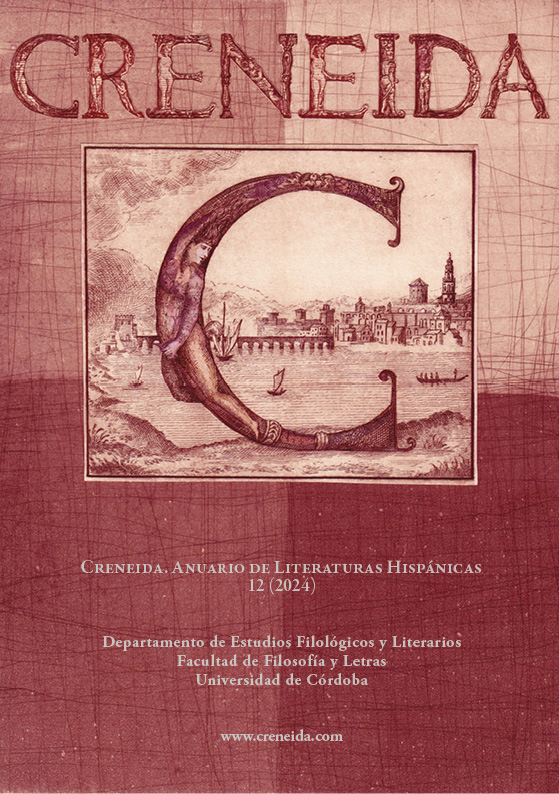Wrinkles, a Rereading of the Graphic Novel for an Approach and Dialogue between Cinema and Literature
Main Article Content
Abstract
This article exhaustively analyzes the main adaptation procedures carried out in the animated film Wrinkles (2011) by Ignacio Ferreras, based on the graphic novel of the same name published in 2007 by illustrator Paco Roca. The focus is mainly on issues related to old age -how this stage of life is socially perceived, the consequences of growing old for oneself, the real possibility of creating emotional bonds in the last years of life-, Alzheimer's disease or the inaction that reigns in old people's homes. A brief note is also made on the current situation of graphic novels adaptations in Spain. Furthermore, it is proposed to reconsider the concept of identification in cinema and replace it with that of emotional adhesion, using the example of Wrinkles.
Downloads
Publication Facts
Reviewer profiles N/A
Author statements
- Academic society
- Creneida. Anuario de Literaturas Hispánicas
Article Details

This work is licensed under a Creative Commons Attribution-NonCommercial-NoDerivatives 4.0 International License.
Avisos de derechos de autor propuestos por Creative Commons
1. Política propuesta para revistas que ofrecen acceso abierto
Aquellos autores/as que tengan publicaciones con esta revista, aceptan los términos siguientes:- Los autores/as conservarán sus derechos de autor y garantizarán a la revista el derecho de primera publicación de su obra, el cuál estará simultáneamente sujeto a la Licencia de reconocimiento de Creative Commons que permite a terceros compartir la obra siempre que se indique su autor y su primera publicación esta revista.
- Los autores/as podrán adoptar otros acuerdos de licencia no exclusiva de distribución de la versión de la obra publicada (p. ej.: depositarla en un archivo telemático institucional o publicarla en un volumen monográfico) siempre que se indique la publicación inicial en esta revista.
- Se permite y recomienda a los autores/as difundir su obra a través de Internet (p. ej.: en archivos telemáticos institucionales o en su página web) antes y durante el proceso de envío, lo cual puede producir intercambios interesantes y aumentar las citas de la obra publicada. (Véase El efecto del acceso abierto).
References
Aumont, Jacques et al., Estética del cine. Espacio fílmico, montaje, narración, lenguaje, Barcelona, Paidós, 1996.
Batista, Diego, “Recovering the Irrecoverable: ‘The Memory of What Matters’ in Three Works by Paco Roca”, en Spanish Graphic Narratives. Palgrave Studies in Comics and Graphic Novels, eds. Collin McKinney y David F. Richter, Londres, Palgrave Macmillan, 2020, pp. 67-84.
Brumme, Jenny y Esteruelas, Clàudia, “From Graphic Novel to Screen. Dialogue Settings in Different Contexts”, en Comics-Übersetzungen und Adaptionen als kulturelle Praxis, ed. Nathalie Mälzer, Berlín, Frank & Timme, 2015, pp. 337-352.
Cañizares Fernández, Eugenio, El lenguaje del cine: semiología del discurso fílmico, Universidad Complutense de Madrid, 1992, [tesis doctoral].
Díaz de Guereñu, Juan Manuel, Hacia un cómic de autor: a propósito de Arrugas y otras novelas gráficas, Bilbao, Deusto, 2014.
Díaz de Guereñu, Juan Manuel, “La ancianidad en dos cómics españoles contemporáneos”, en Representaciones artísticas y sociales del envejecimiento, eds. María Pilar Rodríguez y Txetxu Aguado, Madrid, Dykinson, 2018, pp. 143-160.
Foster, Liam y Walker, Alan (2015), “Active and Successful Aging: A European Policy Perspective”, The Gerontologist, LV, 1 (2015), pp. 83-90.
Fraser, Benjamin, “Senescence, Alzheimer’s Dementia, and the Semi-Subjective in Ignacio Ferreras’s Film Arrugas”, Journal of Literary & Cultural Disability Studies, X, 1 (2016), pp. 21-35.
Fraser, Benjamin, Cognitive Disability Aesthetics: Visual Culture, Disability Representations, and the (In)Visibility of Cognitive Difference, Toronto, University of Toronto Press, 2018.
Gallardo, Miguel y Roca, Paco, Emotional World Tour: diarios itinerantes, Bilbao, Astiberri, 2009.
García-Reyes, David, “Transferencias de la viñeta al fotograma. La narración gráfica y sus adaptaciones fílmicas”, Trasvases. Entre la literatura y el cine, 3 (2021), pp. 9-35.
Li, Shuyi, “Analysis of Time Narrative in ‘The Father’”, Proceedings of the 2022 International Conference on Science Education and Art Appreciation (SEAA 2022), Atlantis Press, 2022, pp. 915-921.
Malpartida Tirado, Rafael, “Subjetividad y adhesión emocional en dos adaptaciones de la novela al cine: ‘La flaqueza del bolchevique’ y ‘Caníbal’, de Manuel Martín Cuenca”, Signa, 24 (2015), pp. 125-145.
Marzal-Felici, Javier y Soler-Campillo, María (2014), “Contemporary Spanish Animated Films: Between the Temptation of the Mainstream and the Consolidation of a National Cinema”, Hispanic Research Journal, XV, 1 (2014), pp. 88-99 (p. 96).
Nagtegaal, Jennifer, “Animation and Affirmative Aging in Ignacio Ferreras’s Arrugas”, Revista Canadiense de Estudios Hispánicos, XLIV, 2 (2020), pp. 437-462 (p. 449).
Perkins, Victor Francis, El lenguaje del cine, Madrid, Fundamentos, 1997.
Roca, Paco, Arrugas, Bilbao, Astiberri, 2007.
Rodríguez Abella, Rosa María, “Las marcas de oralidad en la novela gráfica Arrugas (análisis de su traducción al italiano)”, MonTI Special Issue. Monografías de Traducción e Interpretación, 3 (2016), pp. 131-155.
Rumí, Sonia Gil, “Arrugas (2007), de Paco Roca: la adaptación cinematográfica”, en Las batallas del cómic. Perspectivas sobre la narrativa gráfica contemporánea, eds. Javier Lluch-Prats et al., Universidad de Valencia, 2016, pp. 133-149.
Sanmartín Cava, Josep, “Identificación, conexión e influencia en la experiencia cinematográfica”, SCIO. Revista de Filosofía, 13 (2017), pp. 189-226.
Sola-Morales, Salomé, “Older People, Grandparents… How Men Age in the Cinema”, en Men on the Screen. Re-visions of Masculinity in Spanish Cinema (1939-2019), coord. Juan Rey, Berna, Peter Lang, 2020, pp. 237-248.
Tullis, Brittany, “Paco Roca’s Arrugas, Miguel Ángel Gallardo’s María y yo, and the Impact of Social Comics in Contemporary in Spain”, Interntional Journal of Comic Art (IJOCA), XIV, 2 (2012), pp. 77-89.
Wearing, Sadie, “Frames of dementia, grieving otherwise in The Father, Relic and Supernova: Representig dementia in recent film”, en Critical Dementia Studies, eds. Richard Ward y Linn J. Sandberg, Londres, Routledge, 2023, pp. 100-115.
Wu, Johnathan, “Seeing Through the Eyes of Another: A Brief Review of the 2020 Film ‘The Father’”, American Journal of Psychiatry Residents’ Journal, XVIII, 1 (2022), p. 18.





